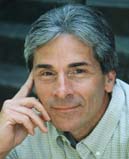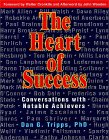| Following Success | |
| by Dan Tripps |

 It was one of those moments that magically escape the abyss of time and remain forever in memory. It also served as the starting point for my lifelong journey in search of achievement. It was 1956. I was 10 years old.
It was one of those moments that magically escape the abyss of time and remain forever in memory. It also served as the starting point for my lifelong journey in search of achievement. It was 1956. I was 10 years old.
Most of the 104,000 wooden seats of the Los Angeles Coliseum were empty. The torch that looms above the eastern archways was dark without the Olympic flame to illuminate the night and the imagination. For all but one athlete and a thousand onlookers, the Olympic Trials were over and Melbourne was the next destination.
Like those at a gospel tent meeting, we who remained knew something special was about to occur, and pushed closer to the metal railing in order to participate in an Olympic Eucharist. A lean, muscular black man in scarlet togs remained alone in the center of the grassy infield. Standing motionless, he stared in silence at the high-jump bar. Standing motionless, we stared in silence at him and his quest. Charlie Dumas and we were staring down the face of immortality as he prepared to jump higher than any man had ever jumped before, and thus remove the mythical seven-foot barrier.
 Under the limited lights of the stadium, Charlie Dumas began the ritual we had come to know so well. Seated straight-legged on the grass, he gracefully bent forward, reaching for his feet, clasped them, and remained motionless, like a ballet dancer awaiting his cue. He rose and walked to the bar and rehearsed his takeoff. He jogged toward the dark end of the stadium fading into the shadows and, seconds later, emerged into the light. We began to clap and call out words of encouragement and the noise echoed in the hollow stadium. He removed his warm-ups, tossing them on a nearby bench. His sweaty black skin and brilliant scarlet uniform sparkled against the sea of grass all around him. He was ready for his third and final attempt. We were ready with him.
Under the limited lights of the stadium, Charlie Dumas began the ritual we had come to know so well. Seated straight-legged on the grass, he gracefully bent forward, reaching for his feet, clasped them, and remained motionless, like a ballet dancer awaiting his cue. He rose and walked to the bar and rehearsed his takeoff. He jogged toward the dark end of the stadium fading into the shadows and, seconds later, emerged into the light. We began to clap and call out words of encouragement and the noise echoed in the hollow stadium. He removed his warm-ups, tossing them on a nearby bench. His sweaty black skin and brilliant scarlet uniform sparkled against the sea of grass all around him. He was ready for his third and final attempt. We were ready with him.
Then, it happened. Swiftly, fluidly, powerfully, Charlie Dumas soared into athletic history, lifting off the Coliseum floor like one of the great birds of the Serengeti clearing the bar with ease. I shouted with delight, as did everyone. Light bulbs flashed. Reporters rushed to the edge of the jump area. Charlie Dumas lay on his back in the sawdust staring up at the dark summer night.
 There was something haunting and beautiful about such an extraordinary moment, and the memory of Charlie Dumas alone with his fears and alone with his triumph burrowed deeply within me. As we left, I decided I would become a high jumper. I would be the one to go eight feet. I would stand on the Olympic platform with tears in my eyes as they played the anthem and raised the flag and the world stood in reverent appreciation.
There was something haunting and beautiful about such an extraordinary moment, and the memory of Charlie Dumas alone with his fears and alone with his triumph burrowed deeply within me. As we left, I decided I would become a high jumper. I would be the one to go eight feet. I would stand on the Olympic platform with tears in my eyes as they played the anthem and raised the flag and the world stood in reverent appreciation.
I never cleared five feet. But, I did long jump rather well. Notable athletic achievement would elude me then and later. But if I couldn't have it, at least I would behold it and live it vicariously through those who did. And so, I watched. And it wasn't just sports. In the fall of 1956, I attended my first opera, Carmen, and felt my body quiver under the spell of the music. In winter I sat riveted to the tiny television in our living room, captivated by the eloquence of Adlai Stevenson and the dignity of Dwight David Eisenhower. There was a stream of remarkable people that flowed through my childhood. Mickey Mantle and Stan Musial. John Kennedy and The Beatles. During my college years, it became a river. Pablo Picasso at the Getty Museum and Aba Eban at the United Nations. Alan Sheppard on the moon and Allen Ginsberg on life.
 And I read. Initially as a teacher, coach, and administrator, I devoured books like Schools without Failure by William Glasser. Later, as an Olympic Committee executive, I studied Leaders: The Strategies for Taking Charge by Warren Bennis, among others. And in my work as a professor of leadership and achievement, Flow: The Psychology of Optimal Experience by Mihaly Csikzentmihaly, In Search of Excellence by Tom Peters, and Leading Minds: an Anatomy of Leadership by Howard Gardner were my fireside companions.
And I read. Initially as a teacher, coach, and administrator, I devoured books like Schools without Failure by William Glasser. Later, as an Olympic Committee executive, I studied Leaders: The Strategies for Taking Charge by Warren Bennis, among others. And in my work as a professor of leadership and achievement, Flow: The Psychology of Optimal Experience by Mihaly Csikzentmihaly, In Search of Excellence by Tom Peters, and Leading Minds: an Anatomy of Leadership by Howard Gardner were my fireside companions.
The names and places and events of the journey have been incredible. And now, 45 years later and as a fairly successful performance psychologist, I teach about achievement to young professionals in athletic and non-athletic endeavors. Now, with some history and perspective, it seemed the right time to talk about success to those who maybe standing at the railing of their own future. I decided the best way to tell the story was to allow those who had achieved to share from their hearts.
 For three years, I crisscrossed America to talk with those who had made it. In hotel lobbies and penthouse apartments, on back porches and pool decks, following their recitals and in between their meetings, at their labs and their vacation retreats, I had the privilege of spending time with some of the most notable people in the land. They have won the World Series and the Nobel Prize, conquered Mt. Everest and Wall Street, held stage at Wimbledon and La Scala, gathered Olympic and Emmy gold, changed history and themselves.
For three years, I crisscrossed America to talk with those who had made it. In hotel lobbies and penthouse apartments, on back porches and pool decks, following their recitals and in between their meetings, at their labs and their vacation retreats, I had the privilege of spending time with some of the most notable people in the land. They have won the World Series and the Nobel Prize, conquered Mt. Everest and Wall Street, held stage at Wimbledon and La Scala, gathered Olympic and Emmy gold, changed history and themselves.
Many of those who speak in the book are famous, due of course to the media attention extended to their careers or intruded into their lives. Many are not, due to the anonymity of their medium or the privacy of their lives. But all of them offer comments and perspectives about achievement, its meaning, and the impact of the journey.
 As I look back, I recognize that the comments they provided are the ones I needed as a struggling high jumper, an aspiring child musician, and still need late in my career. For sure, I could have used them along the way as a parent. I hope they guide you on your own journey, wherever that may take you.
As I look back, I recognize that the comments they provided are the ones I needed as a struggling high jumper, an aspiring child musician, and still need late in my career. For sure, I could have used them along the way as a parent. I hope they guide you on your own journey, wherever that may take you.
Dan Tripps is a Professor of Physical Education at Seattle Pacific University. His first book, The Heart of Success, has just been published by Trans-Atlantic Publications.
